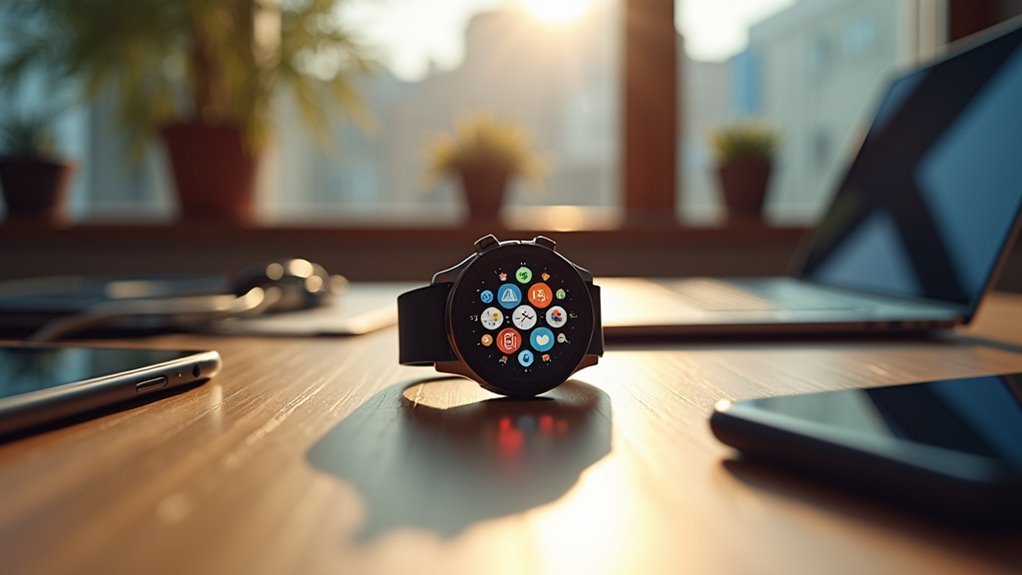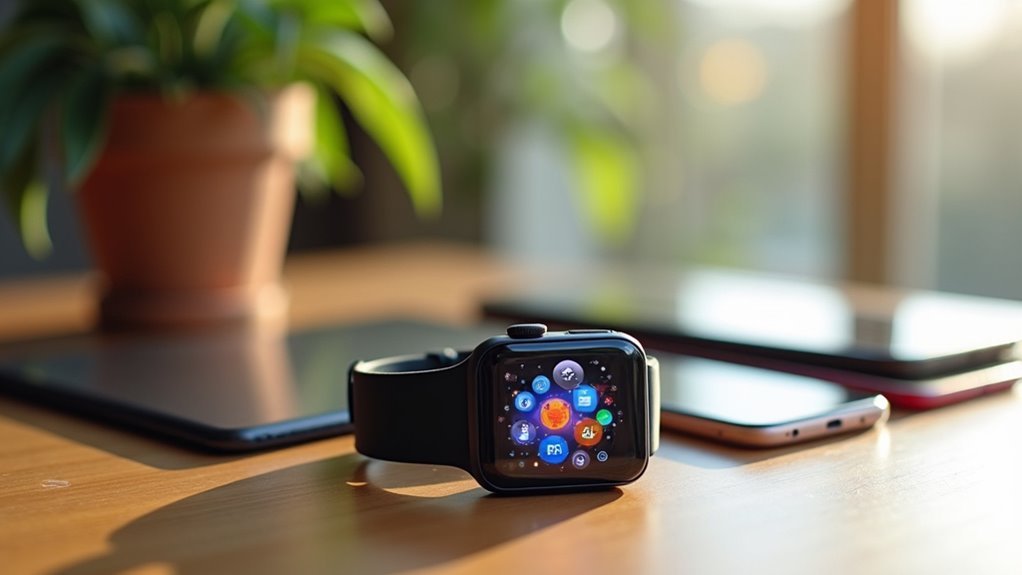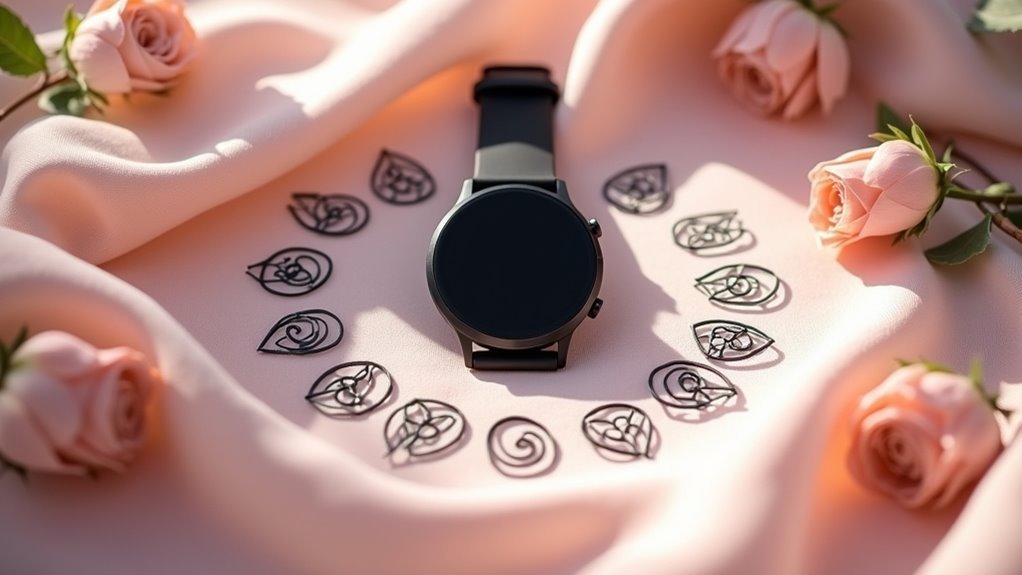You’ll achieve cross-platform smartwatch app success by following three essential strategies. First, choose a framework like Flutter or React Native that matches your team’s expertise while supporting wearable-specific features. Second, design minimalist interfaces that adapt to various screen sizes and shapes, prioritizing glanceability and intuitive gestures across Apple Watch and Wear OS. Third, implement universal data synchronization with unified data models and robust offline handling. Master these fundamentals to reveal advanced optimization techniques.
Choose the Right Cross-Platform Framework for Wearable Development

When developing a smartwatch app that works across multiple platforms, you’ll need to select a cross-platform framework that balances development efficiency with wearable-specific performance requirements.
Flutter stands out for wearable development with its Dart language and modern approach, delivering native-like performance on small screens. React Native offers JavaScript familiarity while maintaining excellent performance for smartwatch interfaces.
Flutter’s Dart language and React Native’s JavaScript both excel at delivering smooth, responsive performance on compact smartwatch displays.
Consider Kotlin Multiplatform if you need shared code with native performance optimization for wearable constraints.
Evaluate your team’s expertise first—choosing a framework that matches your developers’ skills accelerates development. Assess your project’s complexity, performance needs, and budget constraints.
Frameworks supporting AI and IoT integration prove valuable for advanced smartwatch features. Remember that community support and documentation quality greatly impact your development timeline and troubleshooting capabilities.
Cross-platform development significantly reduces time to market and maintenance costs through code reuse across multiple operating systems.
Optimize UI/UX Design for Multiple Smartwatch Operating Systems
After selecting your cross-platform framework, designing an effective smartwatch UI becomes your next priority.
You’ll need to adapt your interface for varying screen sizes, resolutions, and shapes—from rectangular to circular displays. Design minimalist layouts that prioritize glanceability, guaranteeing key information appears immediately without clutter.
Implement intuitive gestures like swiping and tapping while integrating haptic feedback for enhanced interaction. Keep navigation simple and avoid complex functionalities that frustrate users on small screens.
Use brief, purposeful animations and micro-interactions to provide feedback without overwhelming the interface.
Maintain consistent visual identity, typography, and color schemes across all platforms while accommodating accessibility needs. Consider that your interface must accommodate various input methods beyond touch, including physical button interactions for more comprehensive user control.
Test thoroughly on multiple devices to guarantee your design remains crisp and legible across different pixel densities and aspect ratios.
Implement Universal Data Synchronization Across Wearable Platforms

Universal data synchronization forms the backbone of successful cross-platform smartwatch applications, requiring you to orchestrate seamless information flow between diverse wearable ecosystems.
You’ll need to navigate Android Wear, Apple Watch, and proprietary systems while managing their unique APIs and device limitations.
Implement these essential synchronization strategies:
- Deploy unified data models – Create standardized formats that translate consistently across all platforms, reducing debugging complexity and streamlining updates.
- Establish robust sync protocols – Build systems that handle both offline and online states, optimizing payload sizes for efficient cross-device transfers.
- Ensure secure connectivity foundations – Verify Bluetooth pairing integrity, configure automatic background sync, and encrypt all synchronized data to meet privacy regulations like GDPR and HIPAA. Consider implementing blockchain technology as an emerging solution that could revolutionize your sync architecture with distributed ledger capabilities for enhanced security and resilience.
Frequently Asked Questions
What Monetization Strategies Work Best for Cross-Platform Smartwatch Applications?
You’ll maximize revenue by combining subscription models with in-app purchases for premium features. Consider Web2App strategies to bypass platform fees, while integrating non-intrusive video ads that match user interests for additional income streams.
How Do You Handle Battery Optimization Across Different Smartwatch Platforms?
You’ll implement platform-specific power modes, disable always-on displays, use simple watch faces, turn off unnecessary connectivity features, manage app permissions carefully, and monitor battery statistics to optimize performance across different smartwatch platforms.
What Security Measures Are Essential for Wearable Apps Handling Biometric Data?
You’ll need end-to-end encryption for data transmission, multi-factor authentication, secure local storage with access controls, regular security updates, data minimization practices, and user consent mechanisms to protect sensitive biometric information effectively.
How Long Does Cross-Platform Smartwatch App Development Typically Take to Complete?
Cross-platform smartwatch app development takes 4-9 months from planning to launch. You’ll spend 2-4 weeks planning, 1-3 weeks selecting frameworks, and 3-6 months developing and testing, depending on your app’s complexity.
Which Smartwatch Platform Should Developers Prioritize for Maximum Market Reach?
You should prioritize Apple Watch first since it holds 35% market share with high-value users. Then target Android Wear OS for broader device compatibility, capturing the combined 63% market share.
In Summary
You’ll achieve cross-platform smartwatch app success by selecting the right development framework that supports multiple wearable ecosystems. Don’t forget to design intuitive interfaces that work seamlessly across different screen sizes and operating systems. Most importantly, you’ll need to guarantee your app syncs data reliably between devices and platforms. Focus on these three fundamentals, and you’ll create a smartwatch app that delivers consistent performance regardless of which wearable device your users prefer.





Leave a Reply